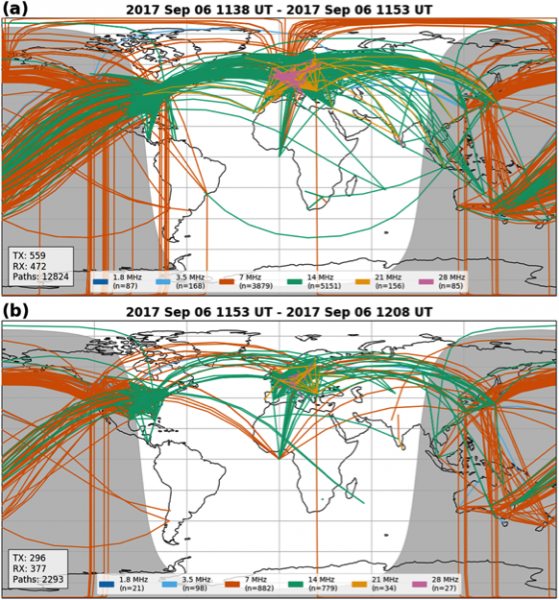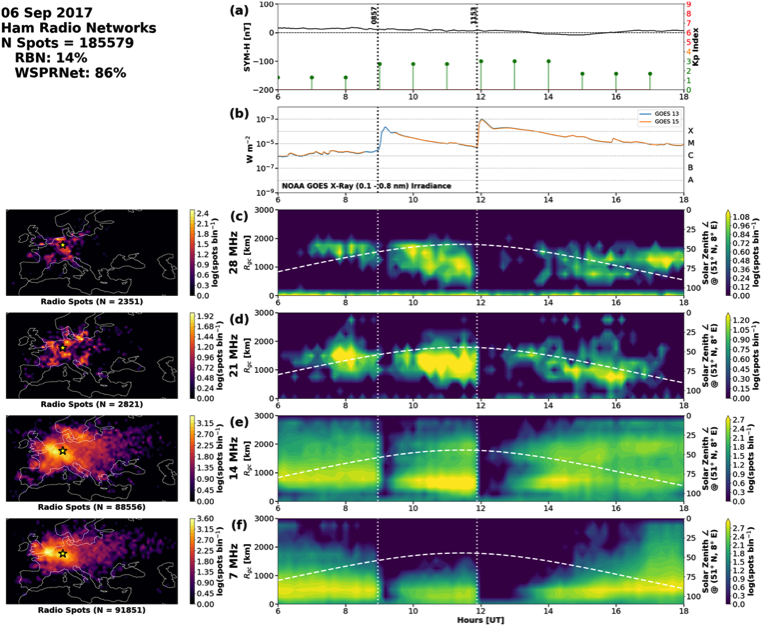Long before satellite communications, high frequency (HF, 3–30 MHz) radio was the primary method for long distance, over-the-horizon wireless communications. HF signals are able to travel long distances by refracting off of the ionosphere in what is known as “skip” or “skywave” propagation. Aside from a transmitter and receiver, no additional technological infrastructure is needed. Because of this, even in the modern age of space‐borne relays and widely distributed Internet availability, HF radio remains a key technology for long‐distance communications. It is actively used by aircraft, ships at sea, military operations, disaster relief efforts, and amateur (ham) radio operators.
The ionosphere is a weakly ionized plasma located between ~60 to 1000 km above the Earth’s surface. It is primarily generated by solar ultraviolet energy ionizing the neutral atmosphere, but ionization can also result from auroral particle precipitation, solar energetic particles, solar x-ray radiation, and more. Additionally, geomagnetic activity and lower atmospheric processes can affect ionospheric density and composition. All of these factors affect HF radio propagation, which may either be advantageous or harmful from a communications point of view. All of this is advantageous in terms of science, as these changes in radio propagation provide an opportunity for remote sensing not only the ionosphere, but the entire coupled geospace system.
Traditionally, the ionosphere is studied using research-grade instruments such as ionosondes, SuperDARN radars, incoherent scatter radars, riometers, and networks of GPS total electron content (GPS TEC) receivers. However, even with all of this instrumentation, the ionosphere is vast and remains undersampled. Recently, it has been shown that the amateur radio community has been making global-scale observations of HF communications for almost an entire solar cycle, and these observations can be used for both ionospheric study and for investigating the impacts of space weather on the terrestrial HF communications systems. Frissell et al. (2019) looks at the impacts of solar flares and geomagnetic storms during a particularly disturbed period in September 2017. Here, we highlight the solar flare/radio blackout event shown in that paper.
Amateur Radio Observations
Amateur (ham) radio operators are licensed hobbyists with an interest in radio communications, engineering, and science. Hams are of all ages and come from all walks of life, and earn their license by passing a knowledge exam given by their respective national government. There are about 820,000 hams in the United States, and over 3 million worldwide. Using technologies such as software define radios, personal computers, and the Internet, hams have built systems that will automatically observe and log certain types of global HF radio communications. These systems include the Reverse Beacon Network (RBN, reversebeacon.net), Weak Signal Propagation Reporter Network (WSPRNet, wsprnet.org), and Phase Shift Keying Reporter (PSKReporter, pskreporter.info). Data from these networks is available either directly from their website, or by contacting the network’s owner. The plots below combine data from both the RBN and WSPRNet.
6 September 2017 Radio Blackout
Solar flares cause radio blackouts because their high amounts of X-ray energy cause a sudden increase in ionization in the lowest layers of the ionosphere, primarily the D region (~60-90 km altitude) (Dellinger, 1937; Chakraborty et al., 2018). Unlike ionospheric regions at higher altitudes which are often approximated as collisionless and generally refract HF rays back to Earth, the D region electron-neutral collision frequency is high causing the HF radio waves to be absorbed when D region densities are elevated (Benson, 1964; McNamara, 1979). Therefore, the X-ray energy from large solar flares can cause HF radio blackouts through a process known as collisional damping.

Figure 1: Amateur radio reporting network results for the (a) 15 min prior to and (b) 15 min following the X9.3 solar flare on 6 September 2017 1153 UT. The propagation paths are color‐coded based on the amateur radio frequency on which the report occurred. The gray and white background shows the diurnal boundary. A reduction in reports can be seen across all frequencies with 7 MHz (dark orange), 14 MHz (bluish green), and 21 MHz (light orange) being the most affected across Europe. (Figure from Frissell et al. 2019)
Figure 1 shows the dramatic impact a solar flare radio blackout can have on HF radio communications. Figure 1a shows RBN and WSPRNet amateur radio communications observed globally for a 15 minute period prior to an X9.3 class flare observed by the GOES spacecraft on 6 Sept 2017 at 1153 UT. A total of 12824 HF radio paths are observed across 6 different frequency bands. A dramatic decrease (82% reduction) in the number of communications can be seen in Figure 1b, the 15 minute period following the flare.
Figure 2 shows a detailed time series of communications over Europe for both the 1153 UT X9.3 class flare and an X2.2 class flare that occurred at 0857 UT, just a few hours earlier. Figure 2a uses the Kp and Sym-H index to show that these flares took place during a period of geomagnetic quiet. Figure 2b shows GOES observations of the solar flares. Figure 2c-f shows histograms of communications distances versus time and spatial maps for each of four major amateur radio bands: 28, 21, 14, and 7 MHz. The location of each communication is chosen as the midpoint between the transmitter and receiver. Immediately following the two X-ray flares, communications cease almost entirely on all bands. Europe was in daylight for both of these events; the white dashed line on each of the time series histograms shows the solar zenith angle for the center of the observations (marked by a yellow star on each map).

Figure 2: Space weather environment and HF radio response over Europe on 6 September 2017 0600–1800 UT. (a) SYM‐H (black line) and Kp (colored stems). (b) GOES‐13 (blue) and GOES‐15 (orange) XRS 0.1–0.8 nm X‐ray measurements. Flares are observed at 0857 UT (X2.2) and 1153 UT (X9.3) and indicated with dotted vertical lines. (c–f) Two‐dimensional contour histograms of RBN and WSPRNet spot data for the 28‐, 21‐, 14‐, and 7‐MHz amateur radio bands, respectively. Bin size is 250 km × 10 min. To the left of each histogram is a map showing the log density of TX‐RX midpoints of all spots used in the histogram. The white dashed lines on the histograms show the solar zenith angle computed for (51° N, 8° E), the point indicated by the yellow star on each map. Radio blackouts across the HF bands can be seen in response to the solar flares in the GOES data. GOES = Geostationary Operational Environmental Satellite; NOAA = United States National Oceanic and Atmospheric Administration; RBN = Reverse Beacon Network; WSPRNet = Weak Signal Propagation Reporting Network. (Figure from Frissell et al. 2019)
Both Figure 1 and Figure 2 show how quickly and dramatically a solar flare can impact HF communications. Radio blackouts are particularly difficult because they are generally impossible to predict. Since the flare X-ray energy travels at the speed of light, we can only know the flare has occurred once it has already arrived. Fortunately, the recombination time of the D region is relatively fast, and communications can resume within just a few hours. Also, solar flares primarily affect only the dayside ionosphere; Frissell et al. (2019) shows a corresponding figure to Figure 2 that shows United States communications were barely affected by the flares because the US was on the dawn flank.
Conclusions
Amateur radio networks provide a powerful method for observing global-scale space weather impacts on the ionosphere and terrestrial HF communications. Here, we highlighted the effects of a solar flare. But Frissell et al. (2019) also shows the more complicated ionospheric response to geomagnetic storms. Similarly, Frissell et al. (2018) used the same data sets and a large-scale, coordinated citizen science campaign to study the ionospheric impacts of the 21 August 2017 solar eclipse. Here, the amateur radio data were combined with forward modeling techniques to relate the observations to physical ionospheric parameters.
To continue and improve upon this work, the Ham Radio Science Citizen Investigation (hamsci.org) has been created. HamSCI is an international collective of both professional researchers and amateur radio operators working together to solve problems in ionospheric and space physics, as well as bring added enjoyment to the amateur radio hobby.
Based on the recent paper: Frissell, N. A., Vega, J. S., Markowitz, E., Gerrard, A. J., Engelke, W. D., Erickson, P. J., et al. (2019). High‐frequency communications response to solar activity in September 2017 as observed by amateur radio networks. Space Weather, 17, 118– 132. https://doi.org/10.1029/2018SW002008
Acknowledgements
NAF acknowledges the support of NSF Grant AGS‐1552188/479505‐19C75. We are especially grateful to the amateur radio community who voluntarily produced and provided the HF radio observations used in this paper, especially the operators of the Reverse Beacon Network (RBN, reversebeacon.net), the Weak Signal Propagation Reporting Network (WSPRNet, wsprnet.org), qrz.com, and hamcall.net. The Kp index was accessed through the OMNI database at the NASA Space Physics Data Facility (https://omniweb.gsfc.nasa.gov/). The SYM‐H index was obtained from the Kyoto World Data Center for Geomagnetism (http://wdc.kugi.kyoto-u.ac.jp/). GOES data are provided by NOAA NCEI (https://satdat.ngdc.noaa.gov/).
References
Benson, R. F. (1964). Electron collision frequency in the ionospheric D region. Journal of Research of the National Bureau of Standards, Section D: Radio Science, 68D(10), 1123–1126.
Chakraborty, S., Ruohoniemi, J. M., Baker, J. B. H., & Nishitani, N. (2018). Characterization of short‐wave fadeout seen in daytime SuperDARN ground scatter observations. Radio Science, 53, 472–484. https://doi.org/10.1002/2017RS006488
Dellinger, J. H. (1937). Sudden disturbances of the ionosphere. Proceedings of the Institute of Radio Engineers, 25(10), 1253–1290. https://doi.org/10.1109/JRPROC.1937.228657
Frissell, N. A., Katz, J. D., Gunning, S. W., Vega, J. S., Gerrard, A. J., Earle, G. D., et al. (2018). Modeling amateur radio soundings of the ionospheric response to the 2017 great American eclipse. Geophysical Research Letters, 45, 4665– 4674. https://doi.org/10.1029/2018GL077324
